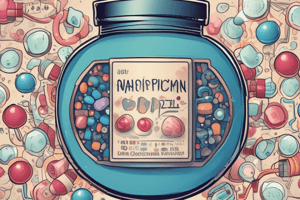Podcast
Questions and Answers
What is vancomycin effective in treating?
What is vancomycin effective in treating?
- Penicillin-resistant Streptococcus pneumoniae
- Fluoroquinolone-resistant Escherichia coli
- Methicillin-resistant Staphylococcus aureus (correct)
- Nafcillin-resistant Staphylococcus aureus
What is the usual adult dose of vancomycin?
What is the usual adult dose of vancomycin?
- 500 mg administered intravenously every 8 hours
- 1 g administered intravenously every 12 hours
- 2 g administered orally every 12 hours
- 1 g administered intravenously over 60 minutes every 8 to 12 hours (correct)
What is the recommended plasma trough concentration above which clinicians believe there is evidence of increased efficacy in patients with endocarditis?
What is the recommended plasma trough concentration above which clinicians believe there is evidence of increased efficacy in patients with endocarditis?
- 20 mg/L
- 5 mg/L
- 10 mg/L (correct)
- 15 mg/L
Why is vancomycin not administered intramuscularly?
Why is vancomycin not administered intramuscularly?
Which of the following patient groups is at greater risk of therapeutic failure with vancomycin therapy?
Which of the following patient groups is at greater risk of therapeutic failure with vancomycin therapy?
What is the minimum inhibitory concentration (MIC) for sensitive bacteria?
What is the minimum inhibitory concentration (MIC) for sensitive bacteria?
What is the recommended duration of infusion to minimize the histamine response associated with vancomycin therapy?
What is the recommended duration of infusion to minimize the histamine response associated with vancomycin therapy?
What is the recommended trough concentration of vancomycin?
What is the recommended trough concentration of vancomycin?
What is the incidence of nephrotoxicity when vancomycin is combined with aminoglycoside antibiotics?
What is the incidence of nephrotoxicity when vancomycin is combined with aminoglycoside antibiotics?
What is the major side effect associated with rapid infusion of vancomycin?
What is the major side effect associated with rapid infusion of vancomycin?
Flashcards are hidden until you start studying
Study Notes
Vancomycin: Introduction
- Vancomycin is an antibiotic effective against gram-positive bacteria, particularly nafcillin- or methicillin-resistant Staphylococcus aureus (NRSA or MRSA).
- It is an alternative to penicillin in patients with a history of serious penicillin allergy.
Administration
- Vancomycin is poorly absorbed orally and must be administered via intravenous route or intraperitoneally for patients receiving continuous ambulatory peritoneal dialysis (CAPD).
- The usual adult dose is 1g (10 to 15 mg/kg) administered intravenously over 60 minutes every 8 to 12 hours.
- Vancomycin is not administered intramuscularly due to pain, local irritation, and histamine reaction.
Therapeutic and Toxic Plasma Concentrations
- The ideal vancomycin plasma concentrations are less than 40 to 50 mg/L, with trough concentrations between 5 to 20 mg/L.
- Peak concentrations greater than 50 mg/L have been associated with ototoxicity, particularly above 80 mg/L.
- The minimum inhibitory concentration (MIC) for sensitive bacteria is less than 5 mg/L, with a limited postantibiotic effect of 0.5 to 3 hours.
Therapeutic and Toxic Plasma Concentrations (continued)
- The MIC for most strains of staphylococcus is less than 5 mg/L, and trough concentrations should be maintained between 5 to 15 mg/L.
- Some clinicians recommend maintaining plasma trough concentrations above 10 mg/L for increased efficacy in patients with endocarditis.
- Patients with nosocomial infections, pneumonia, and other systemic infections with MRSA having an MIC of 2.0 mg/L are at greater risk of therapeutic failure, and may require tailored doses to achieve trough concentrations of 15 to 20 mg/L or an AUC24/MIC ratio of 400.
Side Effects and Toxicity
- The major side effects associated with vancomycin therapy include phlebitis and a histamine reaction presenting as flushing, tachycardia, and hypotension.
- Vancomycin should be infused slowly over 60 minutes to minimize the histamine response.
- Vancomycin is associated with a low incidence of nephrotoxicity as a single agent, but the incidence may increase when combined with aminoglycoside antibiotics.
- Higher rates of nephrotoxicity have been observed when targeting trough vancomycin concentrations of 15 to 20 mg/L or maintaining high-dose therapy for 2 weeks or longer.
Bioavailability
- Oral bioavailability of vancomycin is poor.
Studying That Suits You
Use AI to generate personalized quizzes and flashcards to suit your learning preferences.




